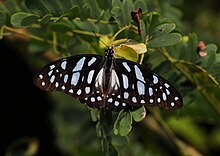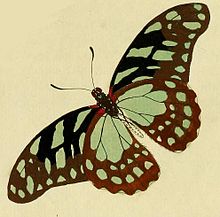Graphium leonidas, the veined swordtail, veined swallowtail or common graphium, is a species of butterfly in the family Papilionidae, found in Sub-Saharan Africa.[2]
| Veined swordtail | |
|---|---|

| |

| |
| Scientific classification | |
| Domain: | Eukaryota |
| Kingdom: | Animalia |
| Phylum: | Arthropoda |
| Class: | Insecta |
| Order: | Lepidoptera |
| Family: | Papilionidae |
| Genus: | Graphium |
| Species: | G. leonidas
|
| Binomial name | |
| Graphium leonidas | |
| Subspecies | |
|
See text | |
| Synonyms | |
| |
Description
editFor terms see External morphology of Lepidoptera
The wingspan is 75–80 mm in males and 75–85 mm in females. Both wings beneath without distinct dark longitudinal streaks on the folds between the veins and without dark longitudinal streaks in the cell of the hindwing. Both wings with submarginal spots. The discal spot of cellule 1 b of the forewing never reaches the base of the cellule. Hindwing usually with free discal spots in cellules 2—5 and with a broad basal transverse band, which covers the greater part of the cell and the base of cellules 1 c, 2, 6 and 7. Forewing always with discal spots in cellules 1 b, 3, 7 and 8, and usually also with small ones in 2, 4, 5 and 6; the cell mostly with three spots. — leonidas F. (= similis Cr.) (7 d). All the spots light blue (male) or bluish white (female); forewing without discal spot in cellule 1 a; the submarginal spots of both wings large; the discal spot of cellule 4 of the forewing is proximally rounded and does not reach the base of the cellule. Sierra Leone, Delagoa Bay, British East Africa. In ab. (?) interniplaga Auriv. the forewing has a large discal onidale. spot in cellule 1 a, otherwise it is similar to the preceding form. German East Africa, ab. (?) onidale Suf. has the light basal part of the hindwing sprinkled with black scales, the veins in that part are margined with black and the spots in cellules 1 c and 2 are small or entirely wanting; otherwise similar to the form leonidas. German East Africa: Muanza. — brasidas Fldr. (7 d). Here the spots on the upper surface are small, white or yellowish white; the submarginal spots dot-like. No discal spot in cellule 1 a of the forewing. Angola to Natal. — umanus R. & J. differs from all the preceding in that the light basal transverse band of the hindwing only extends as far as the base of vein 2. Abyssinia. — pelopidas Oberth. The spots of the forewing light bluish, on an average somewhat larger than in leonidas, the discal spot in cellule 4 reaches the base of the cellule, the basal transverse band of the hindwing is very broad and almost pure white, but the submarginal spots are small, dot-like, not larger than the discal spots. A little known form as yet, perhaps a separate species, although it agrees very closely with leonidas in the markings. German East Africa and Pemba Island. [3]
Biology
editHas continuous broods, peaking from October to April.[4] The larvae feed on Popowia caffra, Annona, Monanthotaxis, Uvaria, Monanthotaxis caffra, Annona senegalensis, Landolphia ugandensis, L. buchannani, Annickia chlorantha, Friesodielsia obovata, Uvaria and Artabotrys species.[2][4]
Subspecies
edit- Graphium leonidas leonidas (Sub-Saharan Africa)
- Graphium leonidas pelopidas (Oberthür, 1879)[5] (Tanzania: islands of Unguja and Pemba)
- Graphium leonidas santamarthae (Joicey & Talbot, 1927)[6] (São Tomé and Príncipe: Principe)
- Graphium leonidas thomasius (Le Cerf, 1924) [7](São Tomé and Príncipe: Sao Tome)
- Graphium leonidas zanzibaricus Kielland, 1990[8] Tanzania
Taxonomy
editIt is the nominal member of the leonidas-group of closely related and similar species (Graphium leonidas, Graphium levassori, Graphium cyrnus).
Images
editReferences
edit- ^ Fabricius, , J.C. 1793. Entomologia Systematica emendata et aucta 3 (1): 35 (488 pp.). Hafniae.
- ^ a b Graphium, funet.fi
- ^ Aurivillius, [P.O.]C. 1908-1924. In: Seitz, A. Die Großschmetterlinge der Erde Band 13: Abt. 2, Die exotischen Großschmetterlinge, Die afrikanischen Tagfalter, 1925, 613 Seiten, 80 Tafeln (The Macrolepidoptera of the World 13).Alfred Kernen Verlag, Stuttgart. This article incorporates text from this source, which is in the public domain.
- ^ a b Woodhall, Steve (2005). Field Guide to Butterflies of South Africa. Cape Town, South Africa: Struik. ISBN 978-1-86872-724-7.
- ^ Oberthür, C. 1879. Catalogue raissone des Papilionidae. Etudes d’Entomologie 4: 1-117.
- ^ Joicey, J.J., & Talbot, G. 1927 New forms of Lepidoptera Rhopalocera. Encyclopedie Entomologique (B.3 Lepidoptera) 2: 1-14.
- ^ Le Cerf, F. 1924 Lepidopteres nouveaux de la collection du Museum (Rhopaloceres). Bulletin du Museum National d’Histoire Naturelle. Paris 30: 137-139.
- ^ Kielland, J. 1990 in Kielland, J. 1990. Butterflies of Tanzania. Hill House, Melbourne and London: 1-363.
- Carcasson, R.H. 1960 "The Swallowtail Butterflies of East Africa (Lepidoptera, Papilionidae)". Journal of the East Africa Natural History Society pdf Key to East Africa members of the species group, diagnostic and other notes and figures. (Permission to host granted by The East Africa Natural History Society
Data related to Graphium leonidas at Wikispecies